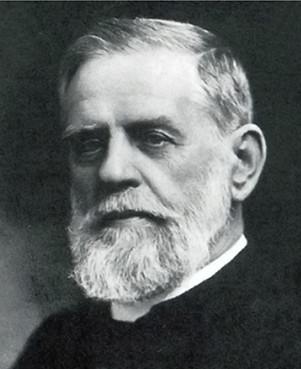Rev. Dr. William Campbell was a Scottish Presbyterian missionary to Formosa (Qing-era Taiwan). Born in April 1841, Campbell graduated from the University of Glasgow, then studied in Free Church Divinity College for four years. He was ordained pastor in 1871 and joined the Presbyterian Church of England. On December 10, 1871, Rev. Campbell arrived in Kaohsiung and later continued to Taiwan as a pastor.
The next year, he visited the aboriginal tribe of Pazeh and baptized some minority people. In 1874, he established a church in Baishuixi of southern Jiayi, but local tyrants like Wu Zhigao violently hindered church construction under the pretext that it was violating feng shui, or Chinese geomancy.
On January 29, 1875, Wu led more than 40 thugs to burn down the chapel and dormitory, rob believers of their belongings, and kill an old woman. Rev. Campbell escaped the calamity and hid himself on a mountain. The issue was called the "Baishuixi Incident".
In spite of the danger of martyrdom, Rev. Campbell traveled all over Formosa, reaching Pitou in the southernmost, Danshui in the northernmost, and Kavalan in the easternmost. On June 6, 1886, he and a pastor began their mission work in Penghu Islands. He became the first missionary to the islands in modern history.
Rev. Campbell felt a great burden for the blind. In his early days in Formosa, he realized that there were many blind people on the island. The blindness might result from congenital disorder, acquired diseases, or unintentional injuries. Formosa had the highest proportion of blind people, compared to other districts; the blind lived a miserable life after becoming beggars.
The pastor wanted to aid them, so he started to raise a fund for the blind while on a furlough in Britain. In October 1891, he signed a five-year contract with an annual cost of 60 yuan to rent a place where he founded a school for the blind, the first school for the blind in Formosa.
After the contract expired, he convinced the Japanese government in Formosa to take over the school. In 1900, the Japanese government took charge of the school and set up an official school for the blind in Tainan. In addition, he did research on braille (reading and writing system for the blind) and compiled a special Bible and books for the blind to read. He often published messages in church magazines conveying love for disadvantaged groups, appealing to believers to take care of vulnerable people.
Speaking English, Fukienese, Dutch and Japanese, he also did much in the writing ministry. His excellent linguistic skills helped him complete the "New Dictionary of the Vernacular or Spoken Language of Amoy" (also known as 甘字典). The dictionary contained over 15,000 vocabularies as well as notes, usage examples and appendixes, valuable to studying and researching Fukienese.
He was also involved in the compilation of Formosa's history. Collecting the data of missionary history in Formosa and the colonial period of Formosa under the Dutch, he wrote the classic books "The Success of the Mission in Formosa" and "Formosa under the Dutch".
He frequently preached the gospel in aboriginal areas in central Formosa. On May 16, 1873, he and other workers found a vast and beautiful lake and named it "Lake Candidius", with the surname of the first missionary to be stationed in Formosa. It is the present day Sun-Moon Lake. He became the man who discovered the famous lake.
After devoting 46 years of his life to Formosa, Rev. Campbell left the island at the age of 76. In 1921, back in the UK, he passed away to be with the Lord, aged 80.
- Translated by Karen Luo












